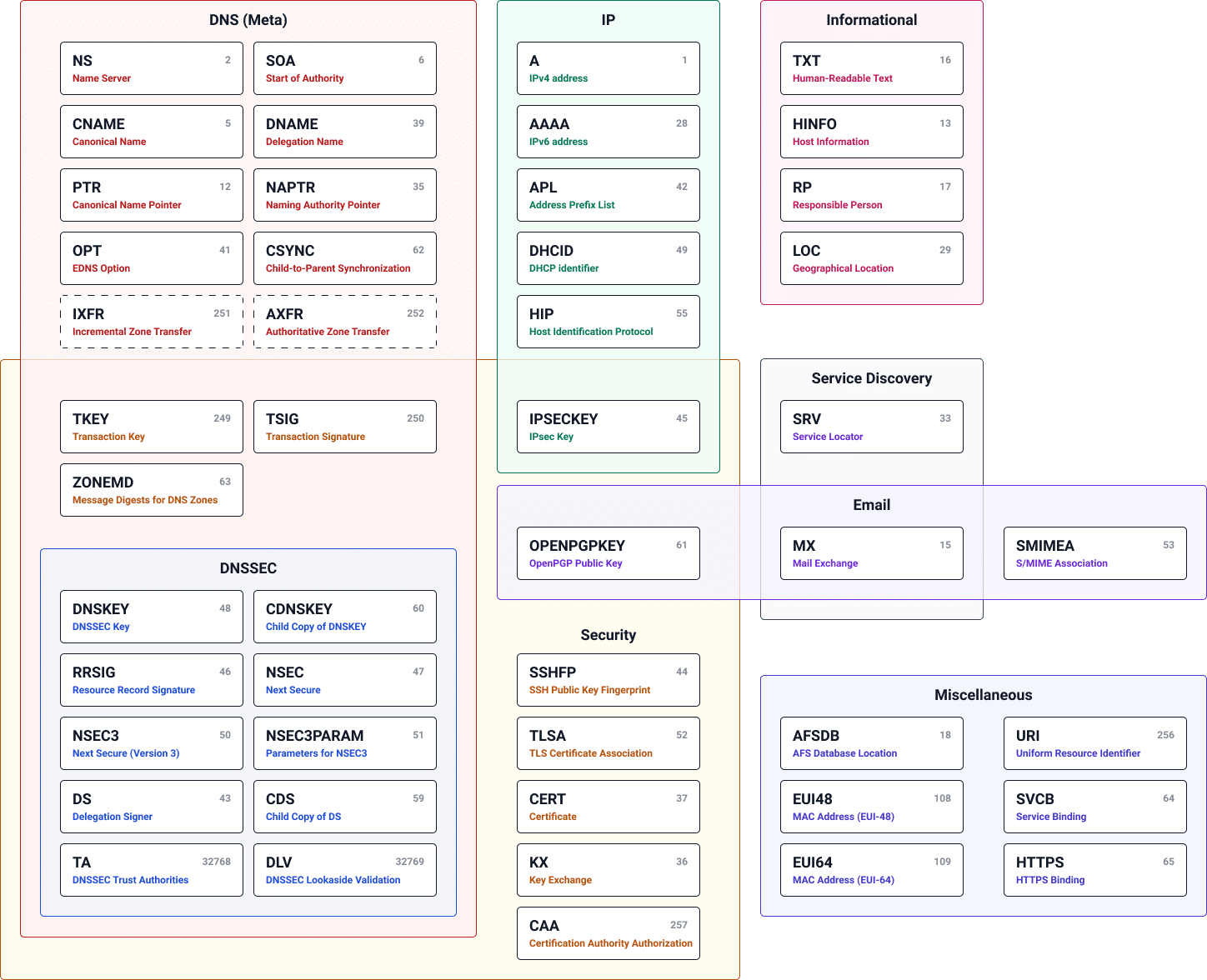Sure! Here’s the translation into American English:
—
The Domain Name System (DNSDNS (Domain Name System) is a domain name system…) is fundamental to the functioning of the Internet, as it translates human-readable domain names into IP addresses understandable by machines. To perform this task, DNS uses several types of records, each with a specific function. Below, we present a detailed technical guide to all types of DNS records.

1. A Records (Address)
Description: An A (Address) record maps a domain name to an IPv4 address (32 bits).
Example:
example.com. IN A 192.0.2.12. AAAA Records
Description: Similar to the A record, an AAAA record maps a domain name to an IPv6 address (128 bits).
Example:
example.com. IN AAAA 2001:0db8:85a3:0000:0000:8a2e:0370:73343. CNAME Records (Canonical Name)
Description: A CNAME (Canonical Name) record maps a domain name to another domain name. It is useful for domain aliases.
Example:
www.example.com. IN CNAME example.com.4. MX Records (Mail Exchange)
Description: An MX (Mail Exchange) record specifies the mail servers responsible for receiving email on behalf of the domain.
Example:
example.com. IN MX 10 mail.example.com.5. TXT Records
Description: A TXT (Text) record allows administrators to store arbitrary text in DNS. It is commonly used for domain verifications and SPF (Sender Policy Framework) settings.
Example:
example.com. IN TXT "v=spf1 include:_spf.example.com ~all"6. NS Records (Name Server)
Description: An NS (Name Server) record indicates the authorized name servers for the domain.
Example:
example.com. IN NS ns1.example.com.
example.com. IN NS ns2.example.com.7. PTR Records (Pointer)
Description: A PTR (Pointer) record maps an IP address to a domain name. It is used in reverse DNS lookups.
Example:
1.2.0.192.in-addr.arpa. IN PTR example.com.8. SRV Records (Service)
Description: An SRV (Service) record is used to define the locations of specific services such as SIP, LDAP, etc. It includes the service name, protocol, name, priority, weight, port, and target.
Example:
_service._proto.example.com. IN SRV 10 60 5060 sipserver.example.com.9. SOA Records (Start of Authority)
Description: An SOA (Start of Authority) record provides information about the primary DNS server for the domain, the person responsible, the domain’s serial number, and various timers that control DNS information updates.
Example:
example.com. IN SOA ns1.example.com. hostmaster.example.com. (
2021070801 ; Serial
7200 ; Refresh
3600 ; Retry
1209600 ; Expire
3600 ; Minimum TTLTTL (Time to Live) is a parameter of the IP header that...
)10. NAPTR Records (Naming Authority Pointer)
Description: A NAPTR (Naming Authority Pointer) record is used for rewriting addresses in applications like ENUM (Telephone Number Mapping).
Example:
example.com. IN NAPTR 100 10 "U" "E2U+sip" "!^.*$!sip:[email protected]!" .11. CAA Records (Certification Authority Authorization)
Description: A CAA (Certification Authority Authorization) record allows domain owners to specify which certificate authorities (CAs) are permitted to issue SSL/TLS certificates for their domain.
Example:
example.com. IN CAA 0 issue "letsencrypt.org"12. DS Records (Delegation Signer)
Description: A DS (Delegation Signer) record contains a public key hash used to sign DNS records in DNSSEC (DNS Security Extensions).
Example:
example.com. IN DS 12345 3 1 ABCDEF1234567890ABCDEF1234567890ABCDEF1213. HINFO Records (Host Information)
Description: An HINFO (Host Information) record provides information about the type of CPU and operating system in use on a host.
Example:
example.com. IN HINFO "Intel" "Linux"14. DNAME Records (Delegation Name)
Description: A DNAME (Delegation Name) record provides aliases for a domain and all its subdomains, similar to a CNAME but applicable to the entire name tree.
Example:
example.com. IN DNAME newexample.com.15. SPF Records (Sender Policy Framework)
Description: Although SPF records can be stored in TXT records, some configurations use specific SPF records to define mail sending policies and prevent spam and spoofing.
Example:
example.com. IN SPF "v=spf1 include:_spf.example.com ~all"Conclusion
Understanding the different types of DNS records and their uses is essential for managing and securing domains on the Internet. From basic name resolution to advanced security and service configurations, each type of record plays a crucial role in network infrastructure. Knowing how and when to use these records can help optimize the performance and security of your online services.
Graphic of DNS records from NSlookup.io.
—
Let me know if you need any further assistance!

